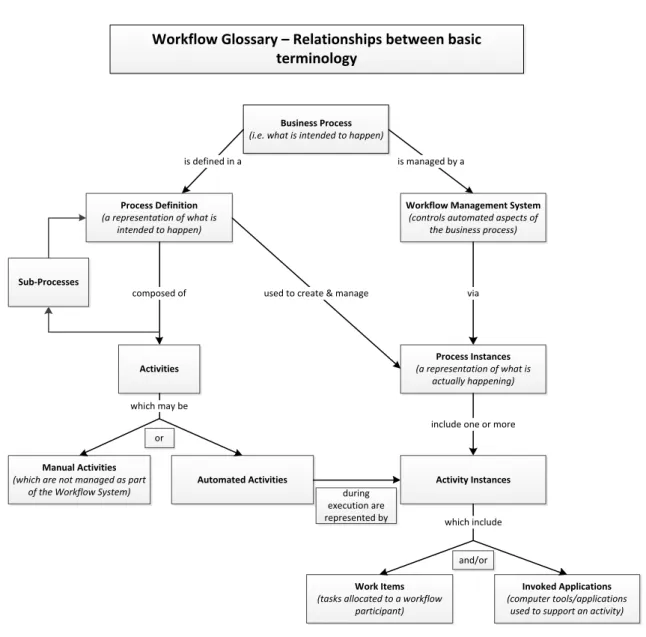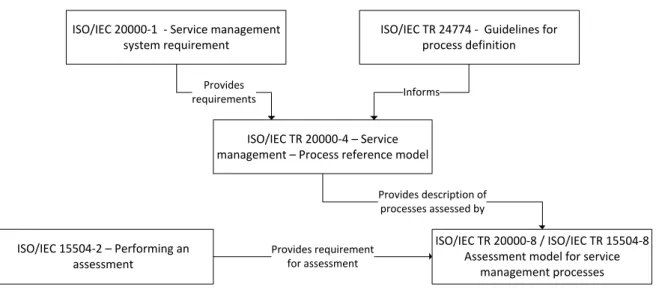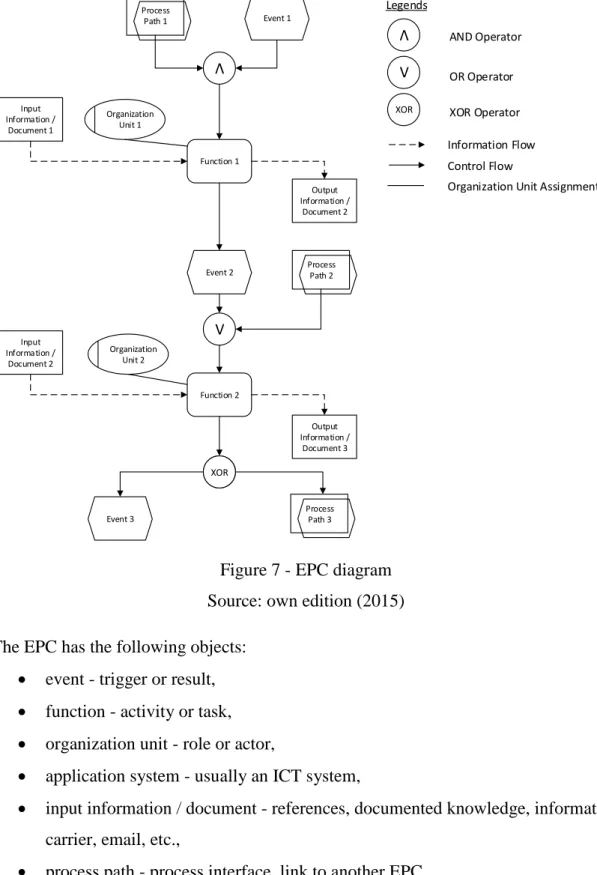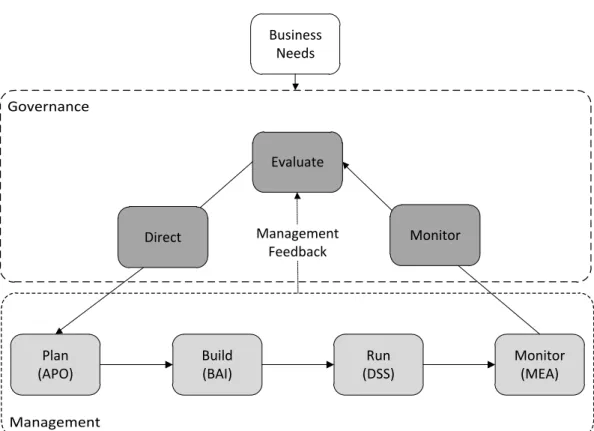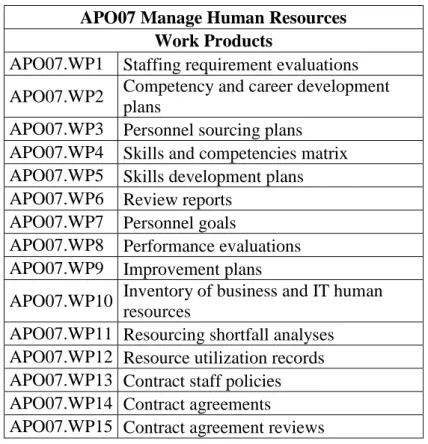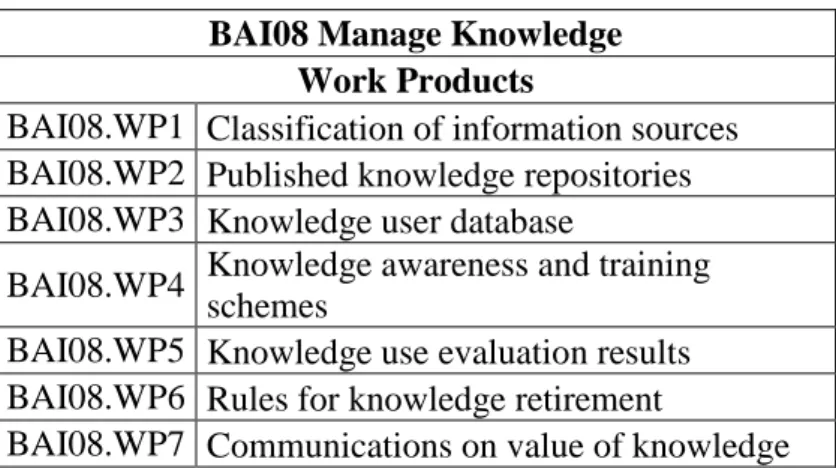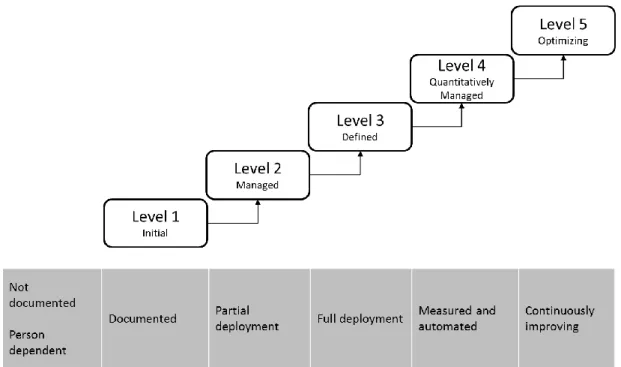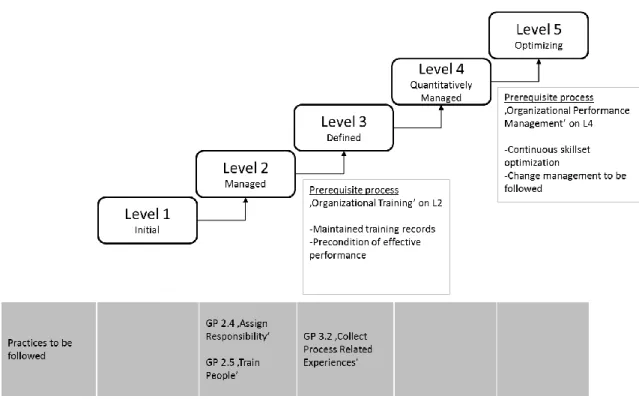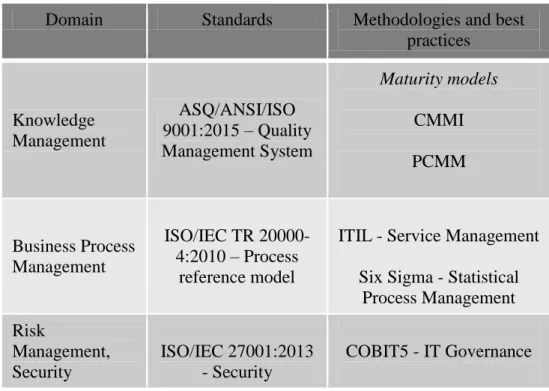Szmodics Péter
Evaluating the organizational knowledge based on business process management
Department of Information Systems
Supervisor: Gábor András, CSc
© Szmodics Péter, 2017
Corvinus University of Budapest Doctoral School of Business Informatics
Evaluating the organizational knowledge based on business process management
Ph.D. dissertation
Szmodics Péter Budapest, 2017
List of Contents
List of Contents ... 1
List of Figures ... 4
List of Tables... 5
ABSTRACT ... 6
1 INTRODUCTION ... 7
1.1 Origin of the research ... 8
1.2 Thesis outline ... 9
1.3 Problem statement ... 11
1.4 Questions ... 12
1.4.1 Question 1 – Can the application of knowledge management be defined at all? What are the limitations of definability? ... 12
1.4.2 Question 2 – Is organizational knowledge assessable with the process management tool and concept library and can it be evaluated? Under what circumstances can the assessment and the evaluation be realized? ... 12
1.4.3 Question 3 – Can the level of knowledge management be defined? Under what circumstances is it possible to determine the levels? ... 13
1.4.4 Question 4 – With what accuracy and relevance can the organizational knowledge management be measured based on business process management? ... 13
1.5 Research methodology ... 14
1.5.1 Qualitative and quantitative research ... 14
1.5.2 Exploratory research and research based on validation ... 15
1.5.3 Research type ... 17
1.5.4 The structure of the research ... 19
1.6 Results and new interrelations ... 20
1.6.1 Question 1 ... 20
1.6.2 Question 2, Question 3 ... 20
1.6.3 Question 4 ... 22
1.7 Novum in research methodology ... 22
1.8 Practical recommendations ... 23
2 BUSINESS PROCESS ... 25
2.1 Basic definitions ... 25
2.1.1 Processes ... 26
2.1.2 Business process ... 28
2.2 Standards ... 33
2.2.1 ASQ/ANSI/ISO 9001 ... 33
2.2.2 ISO/IEC 20000 ... 35
2.2.3 ISO/IEC 27001 ... 37
2.3 Models ... 40
2.3.1 BPMN... 41
2.3.2 EPC... 42
2.4 Methodologies ... 45
2.4.1 COBIT5 ... 45
2.4.2 ITIL ... 49
2.4.3 CMMI ... 56
2.4.4 P-CMM... 60
2.4.5 Six Sigma ... 61
2.5 Interrelations of the standards and methodologies ... 63
3 KNOWLEDGE MANAGEMENT ... 65
3.1 Cognitive infocommunications ... 65
3.2 Data – Information - Knowledge ... 66
3.3 Basic definitions ... 68
3.4 Knowledge-intensive organizations ... 71
3.5 Knowledge management in organizations ... 73
3.6 The source of the knowledge as bridge between the KM and BPM ... 76
3.7 Knowledge representation ... 78
3.8 Technical approach ... 79
3.9 Intellectual capital management ... 81
3.10Amendments ... 84
4 THE RESEARCH METHODLOGY – INTERRELATION OF THE BUSINESS PROCESSES AND THE KNOWLEDGE MANAGEMENT ... 88
4.1 Business process management ... 89
4.2 Knowledge management ... 90
4.3 Renewal ability ... 91
5 RESEARCH ... 93
5.1 Questionnaires ... 94
5.1.1 Collection process ... 94
5.1.2 Background information ... 95
5.2 Results of the questionnaires ... 96
5.2.1 Business process management ... 97
5.2.2 Knowledge management ... 99
5.2.3 Renewal ability ... 102
5.3 Interviews ... 103
5.4 Interpretation of the research results ... 107
5.4.1 Answers to Question 1 ... 111
5.4.2 Answers to Question 2, Question 3 ... 113
5.4.3 Answers to Question 4 ... 118
5.5 Synthesis of the research ... 120
5.6 Generalization of the research ... 122
6 CONCLUSION ... 127
Publication List ... 130
Acronyms ... 132
Glossary ... 135
List of References ... 136
Appendix ... 147
1 Extract from the ASQ/ANSI/ISO 9001:2015 ... 147
2 Extract from ISO/IEC 20000 ... 148
3 Extract from ISO/IEC 27K ... 149
4 Extract from the CMMI Processes and Practices ... 150
5 The relationship between ICM and KM ... 153
6 Core questions ... 154
Domain A – Business process management ... 154
Domain B – Knowledge management ... 155
Domain C – Renewal ability ... 157
7 Correlation coefficient ... 158
List of Figures
Figure 1 - Inductive research... 16
Figure 2 - Deductive research ... 16
Figure 3 - The structure of the research ... 19
Figure 4 - Relationships between basic terminologies ... 32
Figure 5 - Relationships between relevant documents ... 37
Figure 6 - BPMN ... 42
Figure 7 - EPC diagram... 43
Figure 8 - COBIT5 Governance and Management Key Areas ... 46
Figure 9 - CMMI structure ... 57
Figure 10 - CMMI structure with KM ... 59
Figure 11 - SECI model ... 69
Figure 12 - Spiral of Organizational Knowledge Creation ... 70
Figure 13 - Types of knowledge process within an organization ... 75
Figure 14 - Substitute knowledge, Complementary knowledge ... 84
Figure 15 - Model composition ... 93
Figure 16 - Changes of BPs ... 97
Figure 17 - BP documentation up-to-date? ... 98
Figure 18 - KM measurement ... 101
Figure 19 - Relation of Realized value and Knowledge Management level ... 123
List of Tables
Table 1 - Manage Human Resources - Outcomes ... 47
Table 2 - Manage Human Resources - Work Products ... 48
Table 3 - Manage Knowledge - Outcomes ... 48
Table 4 - Manage Knowledge - Work Products... 49
Table 5 - Process thread in the PCMM ... 61
Table 6 - Interrelations of the standards and the methodologies ... 64
Table 7 - Company size... 96
Table 8 - Extract of KM ... 100
Table 9 - Interview - Interviewee profile ... 103
Table 10 - Interview validation - BPM ... 104
Table 11 - Interview validation - KM ... 105
Table 12 - Interview validation - Renewal ... 106
Table 13 - General findings... 108
Table 14 - Competence map ... 110
Table 15 - KM applicable ... 111
Table 16 - High level KM ... 114
Table 17 - Low level KM ... 116
Table 18 - KM based on BPM ... 119
Table 19 - Competence map - KM based on BPM ... 120
ABSTRACT
The continuous technical development has created a dynamic environment which allows the organizations to drive their operations in more realistic and more complex manners. In the developed economic structures the knowledge management is usually handled as the main strategic instrument and a comparative advantage. The knowledge and its management are present in every organizational entity. The awareness about them, the way how they are structured and especially how they are evaluated differ indeed substantially.
Understanding the role of knowledge-based processes is one of the key elements to interpret correctly the possible value chains within the organizations. The current research’s aim is to introduce a pragmatic approach about how to manage knowledge effectively. The domain is quite challenging, on one hand it has to be taken into account how the context of the knowledge is present within the organizations, on the other hand, the practical dynamism of the knowledge management has to be articulated.
The research relies mainly on business process management (BPM) procedures and methodologies, since these can deliver a systemic structure for the relevant processes, for the roles involved in the processes and for the business process management, itself.
Taking into consideration the BPM’s possible sample space, a common understanding about the BPM domain is introduced, in which the knowledge management is embedded.
The desired outcome of the research is to present a holistic, but practical framework about the effective knowledge management based on the business process management. The novum of the research is that it examines the knowledge management’s status within the organizations and it gives an evaluation for that in a practical way.
1 INTRODUCTION
The business process management (BPM) is one of the most interesting domains amongst the research areas nowadays, since it has a direct connection with the core scientific researches and the real life scenarios, too. From this perspective, the knowledge management (KM) is similar to the BPM, it also has direct connection with the research and with real business problems.
The aim of the research is to provide the background on both of the domains: where they originate from, what interrelations they have, and how they are currently situated amongst the given circumstances.
The business process management is enabled and enhanced with the rapid development of the information and communication technology (ICT), the KM’s case is similar. In general, both of them are present within the organizations. Actually, they are not just alive within the business environment, but every slice of human interactions might be also involved in both of the domains. The latter area has a large study field, therefore the current research’s scope is narrowed to examine mainly the business related phenomena, so that can deliver more reliable results with probable better validation.
From a business perspective, it is true for the most markets that there are more competitors who would like to fulfill better the customer’s requirements. The economic space for business entities is usually similar and there is a significant overlapping. The competitors usually have similar resources standing for their provision, that they try to establish comparative advantages with.
Thanks to digitization, the development level in technologies has turned into such a high level, that the most business processes can be structured, replicated and reused. If the business entities want to keep their advantages on the long term, they need to think in a way that is based not only on simple processes, but on processes that get closer and closer to the real mechanisms. If the actors want to drive the market, they have to
come up with such solutions that are not simply copyable and reusable for the competitors. The business entities that follow the forerunners have to strive to be able to adapt to the market leader, copy it or in ideal case, they have to introduce new comparative advantages.
The technical and organizational procedures’ parameters can be set within the workflows of the organizations, but the human actors’ interactions are more likely difficult to be determined. It is partially because of the humans’ perception which might be significantly diverse on individual level. This is mainly caused by the attitude, the motivation and the knowledge. Assessing and evaluating the knowledge of one single person can be already a difficult problem, but handling and managing the knowledge on unit or on higher level is even more difficult, because it has not just more input variables, but more interactions.
The effective knowledge management leans on personnel with good managing and leadership skills and good organizational business processes. The main focus of the research is the latest one, how to transform the BPM’s results into effective knowledge management.
In the next paragraph, the origin of the research is outlined.
1.1 Origin of the research
The technology, the basics of computing and the ICT are connected. Combining them with the business information systems with an outlook on financial studies gives an opportunity to get acquainted with practical business fields.
Bridging the interactions of human actors and the technical environment or amongst human actors with different background (usually with technical and non-technical) is difficult. The technical and documentation-related obstacles can lower the delivered business value, in which the process has to be handled as part of the change management (CM).
The effective knowledge management can significantly enhance the business processes’ efficiency, on the backhand the ineffective one can be the trigger of irreversible losses. The effective business process and knowledge management have not just reflective mechanisms on themselves, but mutual ones on each other, too.
The knowledge has real value addition on business processes and it can provide competitive advantage. While evaluating its value in practice is not easily justifiable, the assessment and measurement of the knowledge management is challenging from both the quantitative and the qualitative aspects. During the ongoing business, the decision-making requires a common framework involving the knowledge management, on every level. Even the business continuity might suffer from the not properly set knowledge management, if not carefully planned. Setting the knowledge management on a balanced and acceptable level without using too many resources is also a complex question.
The aim of the current research is to reveal the relevant results of the academic researches and practices and to give an overview about their current application.
In the next paragraph, the thesis outline is delineated.
1.2 Thesis outline
The thesis has six chapters that build up a line of coherent domains with the respective theoretical background and the related practical methodologies.
In ‘Chapter 1’ the aim and background of the research are introduced, first a short introduction is given which is followed by the thesis outline, this current element shortly lists the parts of the research. Finally, the research’s questions and problem statements are presented where the research methodology is introduced.
‘Chapter 2’ is about the business process management. Its aspect incorporates mainly the organizational roles and the business process management. Particularly their documentation- and complexity-level will be introduced which is interpreted in the research as the basic element of the knowledge management. The theoretical and the
practical key factors of the business processes are also discussed. In addition, the related standards, models and methodologies are reviewed as well.
‘Chapter 3’ covers the knowledge management. The knowledge management’s practice has in scope the followings: documentation of the knowledge, competence mapping of the human resources and the tracing of the knowledge usage.
Understanding the role of the substitute, complementary, rare-unique and business critical knowledge elements is one of the priorities. The other one is how to handle them efficiently. Not just the present state of the knowledge of the specific entities has to be known, but the past and the future ones, too. In addition, the ability to learn and to renew the knowledge can give a projection to the innovation. Similarly to ‘Chapter 2’, the related theoretical background is introduced firstly then the connected concepts.
‘Chapter 4’ sets against the business process management and the knowledge management, since these two fields have common interests and common areas covered. Their intersections are examined in this chapter. The possible gaps and probable causes for misunderstandings are taken into consideration also in order to reveal the expectable problems. After gaining a common understanding about the domains, a holistic framework is collated.
‘Chapter 5’ goes about the discussion of the research questions first by introducing the research itself from practical point of view. In order to piece them together in a realistic way, inputs are being collected from real life examples, the first explanation are done here and then the results are discussed.
‘Chapter 6’ is the conclusion part of the research that elevates the coherent body of knowledge about the so far achieved results and it also provides the basis for future research.
In the next paragraph the research questions are described.
1.3 Problem statement
The research is conducted amongst knowledge-intensive business entities. Knowledge intensity is understood here in a way, wherein the value addition of the organizations is driven mainly by knowledge. Assessing means that there is the possibility to translate the organizational phenomenon within the organizations into a model, in which their specific levels can be depicted. These levels, as an aggregate, can be later on evaluated based on specific requirements and/or best practices. Applicability addresses the usability of the above model; if it fits the requirements then it is applicable, otherwise not.
In the research, the business process management and the knowledge management are examined. The aim is to construct an applicable framework in which the knowledge can be evaluated within a living organization. The basic input is the business process management for assessing this. The framework, how to establish an effective knowledge management practice, is derived from this.
The main problem is how to evaluate the organizational knowledge based on the business process management. The identification, capturing, sharing and reusing the knowledge can usually be assessed and measured just goal-oriented, narrowed to specific cases. Here it is also one of the goals how to give to the problem-set a higher level approach and a more general overview by maintaining the BP- and KM-focus.
Logically the problem is built up as following. Can the knowledge enrichment (Török, 2014), knowledge intensity of the business processes measured or at least delimited?
Can the organizational knowledge practice assessed in a framework taking into the consideration the practical business process management? After setting up the structure, the following should be answered: is it possible to determine the boundaries of the knowledge management? At last, the practical optimum of the knowledge management should be configured.
In the following paragraphs the research questions are explained more detailed.
1.4 Questions
1.4.1 Question 1 –
Can the application of knowledge management be defined at all? What are the limitations of definability?The applicability can cover multiple dimensions at the same time: the surrounding environment, the corporate culture, the size of the business entity, the sector in which it is active, the nature of the business problems, the structure of the business processes and automatization level of the processes. These can be all the parts of the research.
Since the combination of all the elements can create an interminable set, the – from research’s perspective – relevant elements will compose the set of the final evaluation.
Identifying the knowledge intensity is one crutch, evaluating its level within the organization is the other pair of the crutches. Answers to this question can help with determining the connection amongst the business processes and the knowledge management.
1.4.2 Question 2 – Is organizational knowledge assessable with the process management tool and concept library and can it be evaluated? Under what circumstances can the assessment and the evaluation be realized?
Answering this question needs a deep analysis of the business process management itself. The organizational environment and its internal actors should be considered. The organization itself has the regulation and its culture and there are systems embedded, in which or with which the human actors do their interactions. The systems are built up with specific logic and interfaces, normally the workflows are semi-automated. The human actors establish the inputs for the systems depending on the current procedures.
All the human actors have to follow their workflow and they possess definite knowledge that helps them to get along and which drives the business processes.
In order to get answers to this question, it is required to analyze the BPM standards, models, methodologies and the same has to be done with KM. Once these are clarified, their interrelations have to be determined.
The main challenge here is how to highlight the relevant and the necessary (even if they do not seem to be relevant) elements in order to get a general interpretable picture about their proceedings.
If the interrelation of the BPM and KM can be described and, in addition, the knowledge can be measured in a specific environment, the coming question rises apparently.
1.4.3 Question 3 – Can the level of knowledge management be defined? Under what circumstances is it possible to determine the levels?
The optimization is in operations research the selection of the best element from a set of alternatives. Normally the maximizing or minimizing might be the goal of similar activities; in this research, the potential for organizations is examined. The proposed outcome of the research should give an instrument for the organizations about how to balance the costs and benefits during the knowledge management without imposing unnecessary risks. The research does not try to determine the optimal level, but it tries to reveal some steps in order to articulate its predecessors.
In the following paragraph, the potential-related question is put forward.
1.4.4
Question 4 –
With what accuracy and relevance can the organizational knowledge management be measured based on business processmanagement?
Assessing and measuring the knowledge management on organizational level requires a holistic view, since it has to handle more inputs, and at the end, it should somehow summarize the results in a common understanding, preferably in a simple way. Since
this territory is very complex, it should be based on traceable and demonstrable evidences from the input side, the causal analysis should follow a straightforward logic. In addition, the course for presenting the results has to be clear either it is quantitative or qualitative.
If the evaluation of the organizational knowledge can be described in a reasonable structure, its delimitation of it might also be analyzed from a plausibility perspective.
To get the answer for the questions, the practical results of the research have to be outstretched.
In the following sections, the research methodology will be introduced.
1.5 Research methodology
When establishing the structure, the followings were taken into consideration: general scientific expectations, requirements of the Ph.D. school and the nature of the domain to be examined. The current research does not articulate strict hypotheses but it uses rather a set of interrelated questions. Giving answers to these questions gives an exploratory profile to the research. The Corvinus University of Budapest’s Business Informatics Ph.D. School belongs to the field of social sciences, therefore the selected research method might be considered as a relevant one.
In the followings the research will be described in more details, first the basic approach.
1.5.1 Qualitative and quantitative research
During the organizational research, the most common way is to use quantitative or qualitative research.
Quantitative research quantifies the data and tries to give a generalized result on a specific topic, usually a large number of cases represents the specific population. The data collection mechanism might be based on interviews, questionnaires. Its findings
are descriptive based on statistical methods. It can be used to recommend a final answer or a decision. (Babbie, 2003)
The qualitative research tries to develop an understanding about a specific domain, it tries to uncover hidden relationships by generating the common grounds for later quantitative researches. The sample size is usually not representative. Collecting this kind of data is not that structured as in the case of quantitative research, but rather unstructured, applicable form is more like a discussion or depth interview what provides non-statistical data. Its outcome is exploratory. The findings can be used to outline the base for further discussion and quantitative analysis. (Babbie, 2003)
From practical approach, it might be also valid to use the adequate combination of the upper methods, since the same question might be analyzed from different perspectives.
The methodological triangulation (Webb et al., 1966) allows the followings:
simultaneous application of various qualitative procedures,
simultaneous application of various quantitative procedures,
and combination of quantitative and qualitative methods. (Jick, 1979)
In the present research, both of the methods are relevant, and a specific combination of them is used.
1.5.2 Exploratory research and research based on validation
In general, the researchers’ intend is either to set up a new theory or to validate/argue/confute on an already alive one. The current research’s aim is to build up a new theory with the help of already existing theories, practices and a specifically designed research framework.
The logical buildup of the research impels the line of the research. Two main directions are available: the inductive and the deductive approach. The main difference is that the inductive approach’ aim is to generate a new theory and the deductive one’s is to test a theory.
The inductive approach (Figure 1) starts with collecting the relevant data. If it meets the requirements, the next step can follow it: identifying the patterns what later on can be developed into a theory. The inductive approach supports the exploratory research.
(Babbie, 2003)
Figure 1 - Inductive research
The deductive approach (Figure 2) is the reverse process of the inductive one, it starts with the theory and according to it, the hypotheses are set. The data analysis helps to identify whether the hypotheses are supported or not, it is based on validation. (Babbie, 2003)
Figure 2 - Deductive research
The current research domain does not allow the deductive approach at this point, therefore the inductive approach is favored.
The exploratory research is constituted on the inductive logic, it is applicable especially in such cases where the domain is largely unexplored. According to Szabó (2000) the exploratory research has three main goals:
“developing applicable methods for further research,
providing a better background of the domain,
and serving as testing the feasibility of future researches.”
The procedure how the research runs allows a more widen opportunity for the author (Benbasat et al., 1987). Similar researches (Török, 2014, Varga, 2014) utilized this, but before them, there was already an exemplary practice in place (Klimkó, 2001) with similar synthesis. The mentioned thesis’ nature was not validatory, but explorative, the author articulated research-related expectations. “Amongst the questions there are no deductive ones that could be aimed at validating hypotheses. All questions are of inductive nature.” (Klimkó, 2001)
Observation/Information Pattern TentativeHypothesis Theory
Theory Hypothesis Observation Confirmation
In the next paragraph, the realization of the research is introduced.
1.5.3 Research type
There are different research strategies what could be followed, Yin (1994a, 1994b) classified them as the followings:
experiments
historical analysis
procession of a case study
questionnaire surveys
secondary analysis
The current research focuses on business related issues therefore questionnaires and simple case study researches (interviews) in business and management are in the foreground (Eriksson and Kovalainen, 2012). The research area covers organizational processes, company settings including human interactions. Goals and research questions are built on questionnaires and a small number of direct feedbacks.
The research area covers various technical executions, during the design of the research multiple origins of possible data were taken into consideration. Patton’s theory (1999) utilizes also the triangulation. Triangulation uses multiple data sources to produce an understanding. Patton distinguishes the followings:
of data sources (data triangulation),
among different evaluators (investigator triangulation),
of perspective to the same data set (theory triangulation),
and of methods (methodological triangulation)
Data triangulation examines the consistency of different data sources from the same method, e.g. comparing people with different viewpoints. Investigator/analyst triangulation uses multiple analysts. This can be used for understanding the different ways of seeing the data. The theory/perspective triangulation uses multiple theoretical perspectives to interpret the data. The methodological/methods triangulation checks the consistency of findings generated by different data collection methods.
In the following two paragraphs, two currently applicable methodologies are introduced, the questionnaires and the interviews.
Questionnaires 1.5.3.1
The questionnaires help in the research to gather data either in quantitative or qualitative way, from individual units about their attitudes, beliefs, knowledge and opinion about the research-domain. This data collection method is a subset of the general survey techniques. It can be used in the current case in two ways: it is the primary strategy for data collection and it can be used in conjunction with other case study techniques, such as interviewing, observations. (Barlow, 2012)
During the development of the questions, many tactical conditions have to be taken into consideration, especially the issues of designing: how to deal with behavior, how to ask questions about attitudes and intentions, how to use open-ended and closed- ended questions, how to measure knowledge, how to evaluate performance, etc.
(Bradburn et al., 2004)
In case of structured questions, the followings have to be examined: where to use multiple-choice questions (specific choices), dichotomous questions (yes/no multiple- choice questions), and ranking scales questions (for importance, preference relations or orders).
Interviews 1.5.3.2
Although Yin did not directly specify the interviews, they are also being introduced here. An interview is a process of seeking knowledge and understanding via conversation. The interview’s data is transcribed and the transcription is used in the analysis process.
The interviews have the followings of high importance: possible inconsistency- consistency issues, communicational difficulties, attitude, the standardization and length of the questions, and the length of the interviews.
The type of interviews might be: structured (questions and responses are definitive, standardized), semi-structured (predefined questions are asked, but allows expert freedom), unstructured (questions and answers are not specified in advance).
(Chasteauneuf, 2010)
In the coming paragraph the desired combination of 1.4.1, 1.4.2 and 1.4.3 is described.
1.5.4 The structure of the research
Based on the introduced methods and theories, in this point the current research’s structure is explained. The research itself has a historical background from 2014, when the first run of the research took place, the flow of the research is partly based on the result of that.
The data collection happens based on qualitative questions (questionnaire), the outcome is exploratory in order to determine bases for quantitative analysis. The next step is the qualitative result’s transformation into quantitative data. The first analysis is followed by interviews, their goals are to set up a validatory framework. During the interviews the observation-style gets dominant role, the interview-respondent receives wider freedom, the listener will avoid giving advices and getting involved deeper in the content (Figure 3).
Figure 3 - The structure of the research
The research is inductive, the explorative direction is the priority, because at the end a theory-set is built, however there are some deductive approaches during the validatory steps. A combination of quantitative and qualitative methods is used, too. From the triangulation perspective the data, the theory and the methodological ones are used.
Multiple data sources (evidences), theories and methods are used to get confirmation
Preliminary Results Questionnaires Analysis Of
The Results Interviews Validation Of The Results
about the consistency of the examined phenomena. The following section describes the business processes in detail, which is one of the research’s two pillars.
1.6 Results and new interrelations
1.6.1 Question 1
Under what circumstances is the knowledge management applied? Can it be defined?
What are the characteristics?
The set of the possible relevant dimensions are practically infinite, therefore the scope of the research was narrowed to the knowledge intensive organizations. Based on the theories, the standards, and the methodologies the following assumptions were determined: the knowledge management is considered applied when the competencies are documented, if there a knowledge repository in place, if there are training plans, and if the knowledge management is handled on strategic level.
The main outcomes are the following:
the applied knowledge management’s relevance is high in case of cyclical business processes,
the organizations’ work management is based on reliable knowledge,
the digitization of the knowledge management systems is an enabler for other knowledge management-related processes.
At the same time the passive, not utilized knowledge of the workforce is not considered as an inherent part of the knowledge management processes.
1.6.2 Question 2, Question 3
Under what circumstances is the knowledge management measured? Can it be measured? What are the characteristics? Under what circumstances is the applied level
of the knowledge management determined? Can it be determined? What are the characteristics?
The two questions are handled together in the result interpretation.
The organizations have internal workflows and business process management. All the human actors have to follow their workflow, and they possess definite knowledge that helps them to get along and that drive the business processes.
An analysis of the business process management standards, models, methodologies is needed as a prerequisite and the same has to be done with the knowledge management.
The main challenge for measurement is how to highlight the relevant and the necessary (even if they do not seem to be relevant) elements in order to get a general interpretable picture about their processes.
Once the phenomenon is measured, then its relative levels might be assessed.
Identifying the various levels might give an instrument for the organizations about how to balance the costs and benefits during the knowledge management without imposing unnecessary risks. The research does not try to determine the optimal level, but it tries to reveal some steps in order to articulate its predecessors.
In the research, two mutually exclusive sets are discussed: the high level knowledge management, and the low level knowledge management.
Based on the theories, the standards, and the methodologies the following assumptions were determined: the knowledge management can be measured, if the competencies are measured, if the knowledge sharing is known, if the knowledge repository’s utilization is measured, and if the knowledge bearers are measured.
The high level knowledge management’s characteristics show that the reliable knowledge is one of the most significant factors among the interrelations. Another key outcome is that the more highly cyclical business processes and the better measurement of the BPs are positively correlated.
The low level KM is complementary to the high level.
The low level knowledge management applies the most important basic principles of the BPM. The BP documentation is tightly connected to the operative work (critical knowledge elements are taken into consideration). The more hierarchical the organization is, the higher the measurement level is. The higher the measurement level is, the better the employees rely on documented procedures.
1.6.3 Question 4
On what level can the organizational knowledge be assessed and evaluated based on business process management? What are the characteristics?
The organizational knowledge assessment and evaluation are complex, and they should be based on traceable and demonstrable evidences. To get the answer for this question, the practical results of the research have to be outstretched.
The assumptions for the sufficient level of business process management is whether the business processes are identified, whether they are structured and documented, and whether the employees know the BPs.
The substitute and competitive competencies have a very strong correlation and significance. The main conclusion is that having the required level of substitute knowledge bearers within the organization is definitely a competitive factor in organizations where the BPM is on high level.
1.7 Novum in research methodology
The research takes into the consideration not just the related theories, but the practice as well. The standards, the methodologies, and the utilized best practices give an opportunity to enhance the research’s holistic nature with the real business environment. Both the introduced theories and practices give such an alloy that is based on validated results.
Once the relevant inputs are determined, they are measured against real business entities. The measurement is expanded with validatory steps (interviews) in order to check the feasibility of the research. This was proven a strong plus during the research, because it gave more confidence.
Beside the holistic nature of the research, the research is inductive and explorative; the point was to identify such patterns that later on can be developed into a theory.
The results are right by quantified plausibility; however, the domain needs further researches.
1.8 Practical recommendations
The research had a similar, preliminary research, its results and the gained experience could be utilized in this research as the current case is almost identical.
The research covered in the early stage an extent domain about the interrelations of the business process management and knowledge management. With the help of the reviewers, it was acutely narrowed that allowed a more focused research and this decreased the utilized effort. The smaller, better defined domain provided a not too complex dataset.
The aim was to collect one hundred responses. In the practice it turned out that this number cannot be achieved via online questionnaires with the available resources.
Multiple additional personal interactions were needed to reach the aimed number, and in the meanwhile the interactions’ complexity was growing. Collecting the same information on multiple channels (online vs. hard copies) increased the work’s complexity.
The planning of the interviews was easier than expected; fortunately the domain seems to be quite challenging, and many candidates showed interest in it.
One interesting input was from the response-givers that the research should not contain technical terms at all. Even if it seems to be the subject of the common language, in fact, it is not.
During the research just the correlation coefficients were measured, since it was quite exhaustive and it gave a comprehensive and logical picture, it was sufficient in the current case. However, in order to identify more complex interrelations it is recommended to use factor analysis (Kovács, 2011).
Based on the above experience, the main recommendations for researches are:
to limit the extent of the research in order to maintain the focus and the handling ability of the data,
to utilize direct, personal channels instead of indirect (online) channels for primer data collection,
to stick to achievable goals and to estimate the required effort in case of changing the scope, even if it is just a technical change,
to always ask for help if it is needed.
The main outcome is that the research should stick to the research goals, but at the same time it has to be embedded in realistic environment. Beside this, throughout the research, every feedback should be welcomed, especially in the planning phase.
2 BUSINESS PROCESS
In this section, a detailed description is provided about the key factors of the business processes, the related international standards, the most common models, and the methodologies. However, first, the background of the processes is presented.
In the next paragraph, the process-related key definitions are introduced.
2.1 Basic definitions
The processes are present in every science-domain, they have special significance in natural sciences, and therefore a couple of related thoughts are indicated here.
Every process runs in a specific environment, they usually have a start and an end. The essence happens between the start and end, e.g. transformation of goods, producing value added information. There is usually also an actor, who executes a specific task in order to solve the problem that started the process. This arisen event is the trigger event. The processes need resources to be proceeded. In addition, they need time and at least one interaction.
The processes can be reversible or irreversible. The reversible processes can be reversed without causing any particular changes in the system or in the environment.
The irreversible process changes its surrounding elements permanently in each cycle.
In connection to this in physics the entropy is commonly understood as a measure of disorder (Shannon, 1948), on this, both the reversible and irreversible processes have affect. Disorder as a specific state for an organization might be practically interesting, so is the noise. Having noise within the environment has to be mentioned also, because it is a vital element of the complete system. The reversibility, the state of order, and the noise are factors of the systems’ stability. The organization might be in unstable,
neutral, and stable state. The preferred outcome is to determine a stable organization which can be influenced and altered as per the business expectations.
Among the processes there are such which enable the mechanisms for the others, and there are also bottlenecks. Enabling the processes means that the connecting, related processes are triggered, and all of the required resources are at service, so the process can move on. The bottleneck is a kind of limited throughput in the system. With a bottleneck the organization can work just with limited capacity, because there is a weak element in the chain (constraint). Measuring the whole system based on the system theory principles and using the proper algorithms can help with its identification.
In addition, the driver process has to be introduced also. The drivers are those processes that determine the main profile of the specific entities; all of the other processes support these. From business aspect, the driver processes are the value added business processes.
These basic definitions are used later on as an approach in the discussion. The definitions are articulated on a basic level but they are sufficient for the logical reasoning.
In the next paragraph, the organizational processes are analyzed from a general interpretational view.
2.1.1 Processes
There is a growing interest in analyzing processes in connections with organizational activities. There are different perspectives from which the processes can be studied:
the lifecycle of the project: start, development, change, closing;
level-wise: top, middle, bottom, holistic, targeted, etc.
All of the perspectives have their own justification, and in specific environment they can probably be used with high efficiency. In this chapter a logical interpretation is followed, in which three main concepts of the (strategic management) processes are
used, in order to provide a systematic approach for defining the business processes.
(Van de Ven, 1992)
The first of the concepts is a logic that explains causality amongst the dependent and independent variables. This variance theory conception handles the process as an input-process-output model, where input equals to independent variable and output equals to dependent variable (Mohr, 1982). According to Van de Ven (1992), this model is too robust, because the process itself is a black box and clear connection between the input and the output cannot be perceived.
The second one is the category of concepts which “refers to actions of individuals or organizations”. In practice, workflows, communication frequencies and similar activities are the part of this. During the representation of these processes, the actual occurrence can be measured, not how it came off. (Van de Ven, 1992)
The last one is a sequence of events that covers the change over time. There are a lot of remarkable models, the research related are Scott’s (1971) and Greiner’s (1972). Both of them constructed organization development models, and both of them examined the activity phases from the beginning till the end.
Scott covered the main company characteristics and delineated them against the different stages of development: product line, distribution, organizational structure, performance measurement, control system, etc. The main outcome of his model: the more developed the organization is, the more complex problems it can solve. For example, at ‘Level I’ there is a single product, one distribution channel, there is no formal organization structure, performance is measured based on subjective criteria and the control system is on personal-level. Skipping ‘Level II’, on ‘Level III’ there are multiple product lines, multiple distribution channels, the organization is specialized and integrated, the performance management is impersonal, the control is indirect and more likely based on the analysis of the business results.
Greiner determined five stage levels of organizational growth through evaluation and revolution, and assigned problematic areas. The stages are the followings: growth through creativity – leadership crisis, growth through direction – autonomy crisis, growth through delegation – control crisis, growth through coordination – red tape
crisis, and at last, on the top level, there is the growth through collaboration without identified crisis.
Mohr highlights the inputs and the outputs, Van de Ven the interactions, Scott and Greiner emphasize how the organization system’s collaboration is getting more abstract and indirect as the complexity is increasing.
Although Van de Ven’s set is worked out mainly for strategic processes, its logic is quite applicable in case of business processes, too, since it helps a lot with distinguishing the relevant elements because of its matching analogies.
After gaining an organization-related approach, the focus gets narrowed down from the general level. In the next point, the business processes and the related terms are introduced.
2.1.2 Business process
There are multiple definitions for the business process (BP), in the research the following definition is used: the business process is “a collection of activities that takes one or more kinds of input and creates an output that is of value of the Customer”
(Hammer and Champy, 1993). The tasks to be conducted within an organization are directly or indirectly linked, and as one of the outputs they deliver product or service to the business entities’ clients.
Davenport (1993) defines the business process as structured and measured set of activities, with clearly defining the inputs and outputs, and the structure how the specific set of acts are done. This definition has a more emphasis on structuring.
Rummler and Brache (1995) highlight the role of the organization’s external customers, they distinguish the primary processes and the support processes. The primary processes and products can be seen by the external customers, the support processes cannot, but they are essential prerequisites for the primary ones. The primary processes are involved in the direct value addition, the definition is quite close to Porter’s value chain approach (1985), in which the primary activities were operations,
logistics, marketing and service; the secondary activities were the supporting ones, e.g.
procurement, infrastructure management, etc.
Two additional basic concepts have to be listed which are relevant in this topic:
business process reengineering (BPR) and total quality management (TQM). The BPR focuses mainly on the analysis of the workflows and their redesigns, its aim is to reshape the organization fundamentally. According Galliers (1998), it is required to have a “shared vision” and a “review of existing structures and processes” in order to implement successful changes. In order to avoid making unfeasible change proposals, it is necessary for the relevant stakeholders to have a general picture about the current organization. The TQM supports mainly the continuous improvement of an organizational entity, its basic concepts is presented in section 2.4.5.
As a consensual definition, the Hammer-Champy definition is used. In the next paragraph, the workflow’s significance is introduced.
Workflow 2.1.2.1
The BPM and the workflow are expressions that are used in similar environment with similar meaning, especially when they are not properly identified, although they are not identical. “Workflow is a technology used to support business processes”
(Csepregi, 2010). The workflows can be conducted without doing business processes;
however, the workflow engine is the base of BPM. In general, the workflow is really close to the interactions of the coworkers, while the BPM can trigger a higher level procedure (in value, and it is more abstract). The workflows are the parts of the BPMs, and they are the pure technical level of the BPMs. The workflows have a supportive function in order to fulfill the BP’s technical requirements.
According to Gartner’s definition: “the workflow is a form of flow management technology that coordinates interactions between people and software systems” (Hill, 2010). The definition has the same meaning as in the current research. The people are the human and the software systems and the related technologies are the non-human elements. The workflows are usually document- and task-centric, they allow the users
and coworkers to cope with the business problems in a semi-structured or structured way.
Other definitions of workflows are also available: the workflow is “an automation of a business process, in whole or part, during which documents, information or tasks are passed from one participant to another for action, according to a set of procedural rules” (Lawrence, 1997). It can be stated that the definitions are similar, they cover the same approach.
To sum it up the general findings are the followings:
the workflow is an automation of a business process,
the business process is related to those business activities that realize business objectives (and value for the customer).
In the following points, the main characteristics of the BPs are introduced.
Roles and actors 2.1.2.2
The analysis of the relevant or analyzed processes should cover what are conducted, where, when and by whom. The ‘what’ is the specific task, the ‘where’ is the spatial or virtual environment, the ‘when’ is the timely characteristic (interval, deadline), and the
‘who’ is the specific actor who performs the task.
People with diverse background normally share the same values, although the priorities are different (Schwartz and Boehnke, 2004). In order to be able to handle the different background, normalization is needed in the system, the individuals who are the actors of the specific tasks have to work in a controlled environment. In the organizations, there are usually ordinary actors and individuals with high influence (Dear and Moos, 1986), by setting the control environment properly not just their management can be more secured but their recognition, too.
In an organization, the actors can form “a group of participants exhibiting a specific set of attributes, qualifications and/or skills”, this is the definition of the Workflow Management Coalition (WMC, 2015), and it is used for defining the role.
If something should be measured precisely, there is a requirement to maintain a control system, wherein the specific roles’ have defined responsibilities (this approach will be explained in details in 2.4.2). It is also important to consider the possible risk and security related issues as a part of the management (broader background in 2.2.3).
Some relevant topics are discussed later where their justification is in the right place.
In this section, a couple of additional information-focused phenomena are introduced that are related to the role conducting actors.
The not properly identified actors can form unbalanced power within the organization.
The information asymmetry (Stiglitz, 2004) in economics is the part of the decision theory, where one party has better information, and this leads to unbalanced power.
Since the current research is about the process and knowledge management, its significance is high, because the role of the human factor is quite high. Tightly related problems are the moral hazard and the information monopoly, these are not discussed detailed just highlighted as inherent elements of the BPM and KM.
The principal-agent problems (Samuelson and Nordhaus, 2010) are connected to this domain, too, since the asymmetry can cause imperfect information (Osborne, 2004). If the different roles are not appropriately aligned with a common (organizational) interest, then they might alter the business processes according to their own perceptions, goals. The presence of the above problem-sources can support such actors who form unwanted information brokerage; in this case, the issues related to information dissemination and information cascade may pick up.
In the following paragraph, the business process characteristics are aggregated.
The main technical characteristics of the business process 2.1.2.3
Although Hammer and Champy’s (1993) definition is used as the main reference, but an additional deep reference is introduced: the technical side of the realization to make the picture complete. The below technical model (Figure 4) depicts the business processes as a set of directly or indirectly linked activities which as one realize a
business objective within the context of an organizational structure, defining the roles and relationships. (Hollingsworth, 1995)
Business Process (i.e. what is intended to happen)
Process Definition (a representation of what is
intended to happen)
Workflow Management System (controls automated aspects of
the business process)
is defined in a is managed by a
Workflow Glossary – Relationships between basic terminology
Activities composed of
Process Instances (a representation of what is
actually happening) via used to create & manage
Manual Activities (which are not managed as part
of the Workflow System) Sub-Processes
Automated Activities Activity Instances
during execution are represented by
include one or more which may be
or
Work Items (tasks allocated to a workflow
participant)
Invoked Applications (computer tools/applications
used to support an activity) which include
and/or
Figure 4 - Relationships between basic terminologies Source: Workflow Management Coalition (WMC, 2015)
Among the business processes, there are automated and manual activities, parallel and sequential routings, deadlines, and condition handling (particularly pre and post). On Figure 4 it can be seen how the interrelated terminologies cooperate, what the inputs and the outputs are. Most of the elements of the business process management can be handled by the workflow management system from a technical point of view, too.
However, there is an exception: manual activities. These are the activities that are done by human individuals, and this is the complement set of the workflow system that
makes it complete to compose the whole business process management. This is the part where the knowledge management is the most relevant, since this part should be somehow incorporated into systems that are more explicit. This paragraph covered an outlook about the technical side, the research will stick to the original business process definitions (2.1.2).
In the following paragraph, the business process-related standards are introduced.
2.2 Standards
The evaluation and assessing of the knowledge management is a complex task even in the case of small business entities with a low number of possible interactions. In case of larger sizes, the tasks’ complexity grows, especially if there are more functions involved.
The international standards that are based on wide experience are utilized to draw a unified and focused framework of the KM within organizations. In the followings, the most relevant standards are introduced.
The used standards are developed by the International Organization for Standardization (ISO) and its partner organizations. These standards can be used directly (even on international level), or could be tailored as per the domestic requirements (country) and local demands (regulations). The most important benefit of using these standards is that they can significantly raise the awareness about the processes for the cooperating business entities. In the next three paragraphs, the most relevant (knowledge-related) standards are shortly introduced.
2.2.1 ASQ/ANSI/ISO 9001
The ASQ/ANSI/ISO 9001 (ISO 9001) is part of the ISO 9000 family of standards. The ISO 9000, ISO 9001, ISO 9004 and ISO 19011 form the quality management standards. ISO 9000 specifies the terminology, ISO 9004 determines the guidelines
and the elements that have to be considered during the effectiveness and efficiency measurements. The ISO 19011 gives hints for auditing the quality and the environmental management system.
The ISO 9001 standard is about how to adopt a quality management system on strategic level and on operational level. Its main focus is to provide a consistent framework for the business in order to meet the customers’ needs. It clearly defines the general requirements, the documentation requirements, the management responsibilities, the resource management, and the realization of them. In addition, the measurement and improvement opportunities are also stated. This standard is the core of the quality management, and since this is a general standard, its logic is used in every ISO standard.
In case of ISO 9001 one of the most important part is the ‘Human resources’ part in which the competence, the training, and the awareness related requirements are set (ISO, 2015, ASQ/ANSI/ISO, 2015). Additionally, it is stated that there is a requirement to maintain evidences within the system, this one also emphasizes that the process-oriented approach is a main precondition to handle the whole in a system.
The standard first introduces the requirements to understand the organization then the expectations of the interested parties (Clause 4.2 ‘Understanding the needs and expectations of interested parties’). The interested parties can be customers, governments and non-governmental organizations, shareholders, and employees. A proper quality management system (QMS) needs to include the relevant parties’
requirements, related information should be made transparent and available for them and the whole process has to be measured, and - if required - the traceability has to be maintained, too.
The authorities and the responsibilities of the roles have to be assigned, communicated, and understood throughout the organization (‘5.3 Organizational roles, responsibilities and authorities’). The processes should run according to the intended outputs.
Clause 7 covers the support processes (Appendix 1) what addresses the KM in the deepest essence. The ‘7.1.6 Organizational knowledge’ covers the knowledge management expectations. The knowledge has to be determined and it should be fit with providing the required products and services. The knowledge has to be
maintained and made available as the necessity dictates. The change management should take the knowledge into consideration. Acquiring the new knowledge has to be planned based on the current, accessible knowledge. The internal (e.g. captured knowledge, intellectual property) and the external (e.g. from customers gathered knowledge, free online resources) knowledge are both parts of the complete KM. The 7.1.6 points out that the organization should prevent the unintended loss of knowledge and it has to raise the performance in gaining knowledge by establishing a measurement system. Therefore, the knowledge capturing and sharing should be measurable. The critical knowledge elements have to be highlighted and the knowledge gaps have to be identified.
The Clause ‘7.2 Competence’ determines the requirement of the necessary competence. The persons should have the appropriate education, training, and/or experience, where applicable actions have to be taken (e.g. training, mentoring). The evidence of competence has to be documented and maintained. (ASQ/ANSI/ISO, 2015)
In the next paragraph, the service-oriented approach of the ISO is introduced.
2.2.2 ISO/IEC 20000
As long as the ISO 9000 series was developed to help the organizations with implementing a reliable, justified, and evidenced QMS, the ISO/IEC 20000 (ISO 20000) standard might be considered as a complement for the service management, with the same expectations. The service management is a “set of capabilities, including processes, required to direct and control a service provider’s activities and resources to fulfill service requirement as agreed” (ISO/IEC, 2010).
The ISO 20000 is meant for the service management systems (SMS), it specifies the service providers’ requirement for design, transition, delivery, and improvement of services (ISO/IEC, 2010). It can be used for both the service providers and the service buyers (service users), since it can give a consistent framework about the service supply chain and about the measurement. The ISO 20000 does not specify everything
in details, but it gives advice about designing the processes. This standard is commonly used in the ICT service management.
From the knowledge management aspect, ISO/IEC 20000-1’s ‘Chapter 4’ is the most relevant since it covers the resource management, its approach is similar to 9001:2015’s 7.1.6 section (Appendix 2). The QMS scope can include every aspect of the organization, the SMS’ scope is defined for design, transition, delivery and improvement of services (ISO, 2013).
The ‘5.5 Capacity Management’, the ‘5.6 Change management’, the ‘5.7 Configuration management’, and the ‘5.8 Human resource management’ are the most important processes of this part. The human resource as the critical resource for service providing can be assessed in this model.
The ISO/IEC 20000-1 provides the requirements for ‘ISO/IEC TR 20000-4 Process reference model’ (PRM) and ISO/IEC TR24774 informs it about the guidelines for process definition (Figure 5). ISO/IEC TR 20000-4 transforms the inputs into a process reference model, this model requires beside the business logic representation of the service management the alignment of the entity-specific expectations. The reference model is described with specific purposes and related outcomes, these purposes and outcomes are the minimum necessity to meet the ISO/IEC 20000-1 requirements.
As an end step the processes are assessed based on the PRM and according to the principles of ISO/IEC 15504 (ISO 15504). The purpose of this part “is to facilitate the development of a process assessment model” (ISO/IEC, 2010). The process reference model, derived based on the requirements of ISO 15504, should be a logical representation of the process elements within the service management (Kunas, 2012).
ISO/IEC TR 20000-4 – Service management – Process reference model
ISO/IEC TR 20000-8 / ISO/IEC TR 15504-8 Assessment model for service
management processes ISO/IEC 15504-2 – Performing an
assessment
ISO/IEC 20000-1 - Service management system requirement
ISO/IEC TR 24774 - Guidelines for process definition
Informs Provides
requirements
Provides description of processes assessed by
Provides requirement for assessment
Figure 5 - Relationships between relevant documents Source: own edition (ISO/IEC, 2010)
The ISO/IEC TR 20000-4 is the core of the whole process, the PRM allows to think in a measurable environment that can be the base for assessment. The most important parts are the ‘5.5 Capacity management’, the ‘5.6 Change management’, the ‘5.7 Configuration management’, the ‘5.8 Human resource management’, and the ‘5.9 Improvement’.
For service management, these standards give the assessment foundation. In order to enhance the QMS and the service management, it is also needed to focus on those elements that might have negative effect on the BPs’ outcomes. The next standard targets this question.
2.2.3 ISO/IEC 27001
The ISO/IEC 27001 (ISO 27001) is for those organizations that would like to keep information assets secure. It covers the requirements of the risk management (RM), the security awareness, and the business continuity management (ISO/IEC, 2013, ISO/IEC, 2016a).
The structure of this standard is similar to the two former ones (Appendix 3 covers examples from the whole ISO/IEC 27K for demonstration purposes), the common
